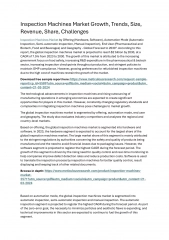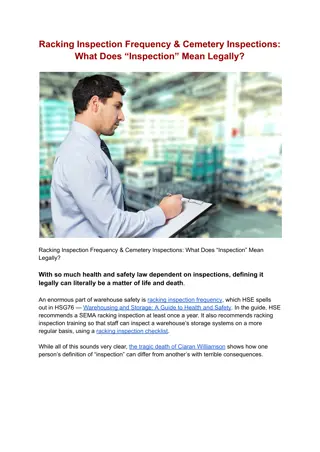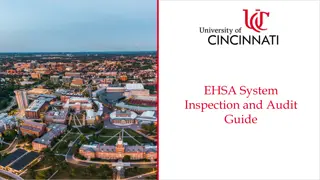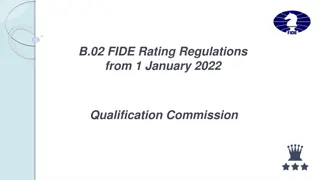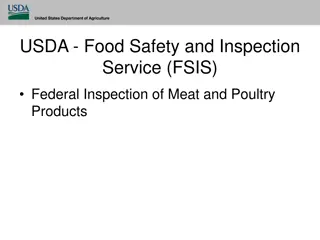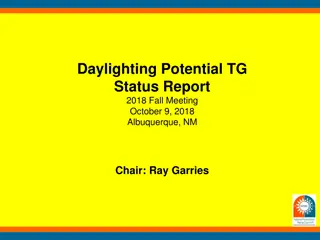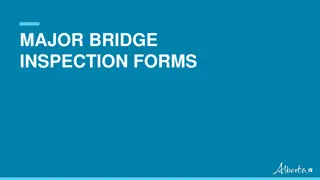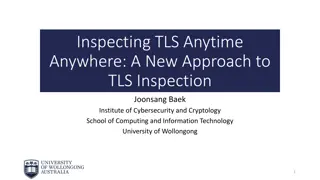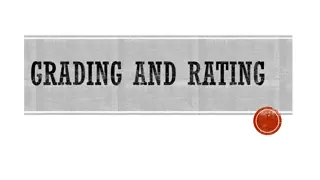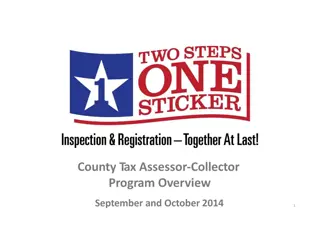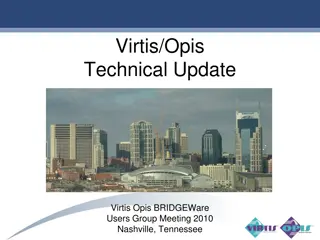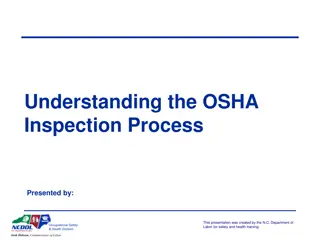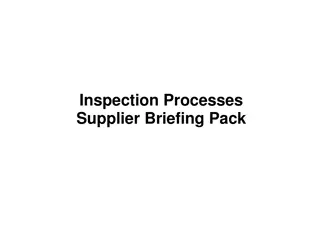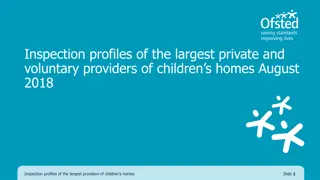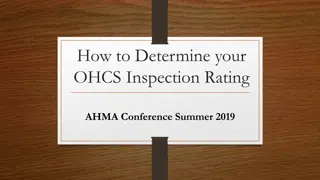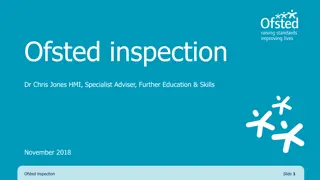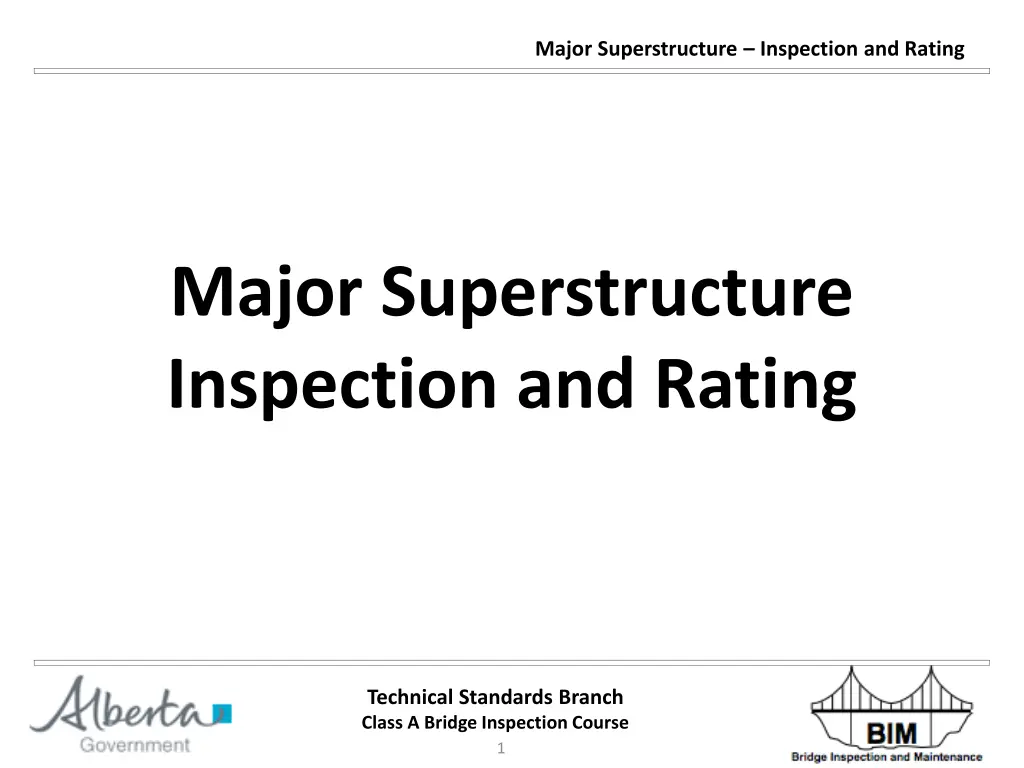
Superstructure Inspection and Rating Overview
Learn about the Major Superstructure Inspection and Rating process, including details on wearing surface types, inspection procedures, and record-keeping requirements. This comprehensive course covers aspects such as bridge deck protection, traffic wear assessment, skid resistance evaluation, and more. Gain insights into different types of wearing surfaces like asphalt, timber, polymer membranes, and concrete overlays. Understand how to assess the condition of wearing surfaces by observing traffic, identifying defects, and checking for debonding or loss of aggregate. Get equipped with the technical standards required for Class A Bridge Inspection.
Download Presentation

Please find below an Image/Link to download the presentation.
The content on the website is provided AS IS for your information and personal use only. It may not be sold, licensed, or shared on other websites without obtaining consent from the author. If you encounter any issues during the download, it is possible that the publisher has removed the file from their server.
You are allowed to download the files provided on this website for personal or commercial use, subject to the condition that they are used lawfully. All files are the property of their respective owners.
The content on the website is provided AS IS for your information and personal use only. It may not be sold, licensed, or shared on other websites without obtaining consent from the author.
E N D
Presentation Transcript
Major Superstructure Inspection and Rating Major Superstructure Inspection and Rating Technical Standards Branch Class A Bridge Inspection Course 1
Major Superstructure Inspection and Rating Wearing Surface Bonded or fastened to the deck In direct contact with the traffic Not part of the structural deck Purpose Protects the bridge deck traffic wear salt and water infiltration Provides a smooth wearing surface Provides skid resistance Technical Standards Branch Class A Bridge Inspection Course 2
Major Superstructure Inspection and Rating Wearing Surface Types Asphalt Timber untreated treated Polymer membranes Concrete overlay silica fume high density latex modified other (Pyrament) fibre reinforced May have more than one type i.e. polymer membrane on concrete overlay Technical Standards Branch Class A Bridge Inspection Course 3
Major Superstructure Inspection and Rating Wearing Surface Drive over deck at design or posted speed Observe traffic crossing bridge Look for deflections or movement Listen for unusual noises Look for defects common to the material Look for debonding, loosening or loss of wearing surface Sound for debonding using hammer if suspected Look for protruding nails in timber wearing surfaces Look for loss of aggregate from polymer wearing surfaces or seal coats Look for polishing of concrete overlays especially high density Technical Standards Branch Class A Bridge Inspection Course 4
Major Superstructure Inspection and Rating Wearing Surface TT, TH and PT forms PCS and PSR only PCS, PSR, SG, SS, DT and CON forms Technical Standards Branch Class A Bridge Inspection Course 5
Major Superstructure Inspection and Rating Wearing Surface Record or verify type Record or verify Thickness Size (TH & PT only) Record or verify the presence of Lateral Connection Problem (Y/N) PSR and PCS only Rate under girders If no wearing surface, rating is for Deck Top TH, PT and TT only Technical Standards Branch Class A Bridge Inspection Course 6
Major Superstructure Inspection and Rating Wearing Surface Record in Explanation of Condition location, severity and extent of Wear Scaling / raveling Cracks Debonding Wearing surface loss Technical Standards Branch Class A Bridge Inspection Course 7
Major Superstructure Inspection and Rating Wearing Surface Rate according to existing condition and functionality If wearing surface does not have sufficient skid resistance rate 4 or less If wearing surface does not cover the entire deck (curb to curb) rate 4 or less rate 2 if traffic hazard Exposed nails or other fasteners rate 4 or less If speed has to be reduced due to potholes, missing planks, ruts or other deterioration rate 3 Technical Standards Branch Class A Bridge Inspection Course 8
Major Superstructure Inspection and Rating Wearing Surface Concrete Overlay Rating Guide Crack definitions Hairlines <0.1 mm Narrow >0.1 mm and <0.3 mm Medium >0.3 mm and <1.0 mm Wide >1.0 mm Technical Standards Branch Class A Bridge Inspection Course 9
Major Superstructure Inspection and Rating Wearing Surface Asphalt Pavement Condition Severity Guide Rating Ravelling Cracking 5 Some loss of Material Less than 10mm interconnecting cracks 10 to 20mm Alligator pattern, corners of polygons fracturing 4 Shallow disintegration of surface, open texture 3 Shallow disintegration of surface, small potholes, open texture, loose material 20 to 30mm no ravelling Alligator pattern, spalling of polygon blocks Greater than 30mm ravelling edges Alligator cracking, blocks lifting, potholes 2 Deep disintegration of surface, numerous potholes. Very open texture, loose material Technical Standards Branch Class A Bridge Inspection Course 10
Major Superstructure Inspection and Rating Wearing Surface Asphalt Pavement Condition Severity Guide (Part 2) Rating Flushing Slipperiness Rutting and Surface Distortion Under 10 mm 5 Variable color, localized Skid number veining 40 to 50 Skid number 4 Distinct color, 10 mm to 25 mm free asphalt 30 to 40 Skid number 3 Wet look. Traffic leaves 25 mm to 50 mm tire marks and noise Excess free asphalt, wet look, footprints 20 to 30 Skid number 2 Over 50 mm under 20 Technical Standards Branch Class A Bridge Inspection Course 11
Major Superstructure Inspection and Rating Wearing Surface Wearing Surface Rating Guide - ACP Rating Alligator / Longitudinal / Transverse / Random Cracking Loss (potholes and patches) Debond Cracking, Ravelling, Rutting and Surface Distortion, Flushing, Slipperiness < 1/30 m/m2 < 1/10 m/m2 < 1/3 m/m2 < 1/1 m/m2 6 5 4 3 < 1% < 3% < 10% < 30% Light Moderate Heavy < 1% < 3% < 10% Technical Standards Branch Class A Bridge Inspection Course 12
Major Superstructure Inspection and Rating Wearing Surface Wearing Surface Rating Guide Polymer / Seal Coat Rating Seal Coat Loss Polymer Debond / Loss Polymer Cracking Slipperiness < 1% 7 6 < 1% < 1/30 m/m2 < 1/10 m/m2 < 1/3 m/m2 < 1/1 m/m2 > 1/1 m/m2 < 3% < 10% 5 4 < 3% < 10% Light Moderate < 30% over 30 % 3 2 < 30% > 30% Heavy Severe Technical Standards Branch Class A Bridge Inspection Course 13
Major Superstructure Inspection and Rating Deck Drainage Not included on TT, PT or TH forms Poor drainage Common cause of deck deterioration May cause a hazard due to hydroplaning or icing Caused by inadequate design, construction or maintenance practices May affect other bridge elements superstructure substructure headslopes and sideslopes Drainage system includes gutters, inlet boxes, scuppers, downpipes and catch basins drainage problems at deck joints sealed with plumbing non-watertight Technical Standards Branch Class A Bridge Inspection Course 14
Major Superstructure Inspection and Rating Deck Drainage Deck Drain Technical Standards Branch Class A Bridge Inspection Course 15
Major Superstructure Inspection and Rating Deck Drainage Technical Standards Branch Class A Bridge Inspection Course 16
Major Superstructure Inspection and Rating Deck Drainage Check for: plugging of inlet boxes, scuppers, downpipes and joint plumbing corrosion of metal components gouges, cracks, breaks or tears joint seals integrity of attachments and connections loose or missing bolts cracked or broken welds loose or open connections length of downpipes Technical Standards Branch Class A Bridge Inspection Course 17
Major Superstructure Inspection and Rating Deck Drainage Check for: signs of ponding on the deck damage to the deck, curbs, girders and substructure staining (water and rebar corrosion) scaling freeze-thaw delaminations spalling erosion below downpipe Technical Standards Branch Class A Bridge Inspection Course 18
Major Superstructure Inspection and Rating Deck Drainage Record or verify if drains or joint plumbing is clogged Technical Standards Branch Class A Bridge Inspection Course 19
Major Superstructure Inspection and Rating Deck Drainage For timber decks or steel grating not on TT, TH & PT forms water ponded on the deck rate 4 or less water ponding is a hazard rate 2 drains leak or downpipes too short rate 4 or less ponding, leakage or discharge causes significant deterioration of deck, curbs, girders or substructure rate 3 or less erosion on sideslopes or headslopes from discharge rate 4 or less Deck joint leakage causing damage - reduce rating Technical Standards Branch Class A Bridge Inspection Course 20
Major Superstructure Inspection and Rating Deck Top/Underside Purpose Carries traffic loads Transfers loads to main structural members Can be in direct contact with traffic in the absence of a wearing surface Types Cast in place concrete Precast concrete Timber Steel grate Separate ratings for top and underside Except for PCS, rate underside with top and girders May not be inspectable from the top Wearing surface Snow, ice or gravel Technical Standards Branch Class A Bridge Inspection Course 21
Major Superstructure Inspection and Rating Deck Top/Underside Drive over deck at design or posted speed Observe deck under traffic Listen for unusual noises Look for deflections or movement Look over deck top and underside for problems with material On concrete decks, sound suspect areas with a hammer to detect delaminations Birdbath locations Stained areas Badly cracked areas or adjacent to large cracks Technical Standards Branch Class A Bridge Inspection Course 22
Major Superstructure Inspection and Rating Deck Top/Underside Deck Top rated separately except for PT, TH and TT where Wearing Surface / Deck Top combined Applies to PT, TH and TT only Applies to DT and SS only Remainder applies to SG, PSR, CON, DT and SS Technical Standards Branch Class A Bridge Inspection Course 23
Major Superstructure Inspection and Rating Deck Top/Underside Record or verify subdeck type and size for TH, PT& TT Record or verify deck underside % defects for TH, PT & TT % stains for all others Record if snow slots filled for DT & SS Record location, severity and extent of Staining Scaling Cracks Delaminations Spalling Technical Standards Branch Class A Bridge Inspection Course 24
Major Superstructure Inspection and Rating Deck Top/Underside Rate according to existing condition and functionality Speed reduced due to deterioration rate 4 or less Surface does not have sufficient skid resistance rate 4 or less Steel grating connections are loose or broken rate 4 or less improper bearing or support on girders rate 4 or less Timber minor splitting in non-adjacent planks - rate 5 or more any rot - rate 4 or less broken planks - rate 4 or less connections loose or broken - rate 4 or less Technical Standards Branch Class A Bridge Inspection Course 25
Major Superstructure Inspection and Rating Deck Underside Concrete Deck Rating Guide Crack definitions Hairline <0.1 mm Narrow >0.1 mm and <0.3 mm Medium >0.3 mm and <1.0 mm Wide >1.0 mm Technical Standards Branch Class A Bridge Inspection Course 26
Major Superstructure Inspection and Rating Deck Underside Concrete Staining Deck Rating Guide Severity Rating Description Efflorscence or exudation at cracks. Light grey damp appearance 5 Dark grey damp appearance 4 Efflorescence or exudation in satined areas Light rust stains 3 Heavy rust stains 2 Technical Standards Branch Class A Bridge Inspection Course 27
Major Superstructure Inspection and Rating Concrete Girders Purpose Receive the loads from the deck Transmit the loads to the substructure (through the bearings) Three types Cast-in-place standard reinforced Standard reinforced precast Prestressed or post-tensioned precast Technical Standards Branch Class A Bridge Inspection Course 28
Major Superstructure Inspection and Rating Concrete Girders Inspection is primarily visual, looking for Staining Scaling Cracks Delaminations Spalling Observe girders under traffic and look for unusual deflections or movement Independent movement on laterally connected girders Evidence of grout key or lateral connection failure Cracking or loss of grout in grout key Cracking in pavement Corrosion, or missing, loose or broken bolts at channel connectors staining on underside of keys Technical Standards Branch Class A Bridge Inspection Course 29
Major Superstructure Inspection and Rating Concrete Girders Grout key failure Deck Top Crack Candy Cane Bar (Typ.) Grout Girder Edge Girder Edge Gap Technical Standards Branch Class A Bridge Inspection Course 30
Major Superstructure Inspection and Rating Concrete Girders On post-tensioned girders check end anchorage zones Check for corrosion of prestressing or post-tensioning cables rust stains or cracking along sides of girders leakage onto ends of girders with staining from ends of cables Cracking in end anchorage zone of prestressed girders High load damage which breaks the concrete around the pre- or post-stressed cables Look for damaged or broken cables Technical Standards Branch Class A Bridge Inspection Course 31
Major Superstructure Inspection and Rating Concrete Girders Record or verify the presence of cracking PCS, PSR & CON Not hairline/narrow flexural on PCS or CON Record or verify the amount of spalling in % PCS and PSR Corrosion induced spalling on bottoms and sides over stirrups only % of total leg or girder length Girder Detail Ratings on PCS forms only Technical Standards Branch Class A Bridge Inspection Course 32
Major Superstructure Inspection and Rating Concrete Girders Record in Explanation of Condition location, severity and extent of Staining Scaling Cracks Delaminations Spalling Grout Key failure Technical Standards Branch Class A Bridge Inspection Course 33
Major Superstructure Inspection and Rating Reinforced Concrete Girder Rating Applies to all plain reinforced concrete girders Not prestressed or post-tensioned If curb girder only affected, can increase ratings by one Has lower load carrying function Does not apply to shear cracks Technical Standards Branch Class A Bridge Inspection Course 34
Major Superstructure Inspection and Rating Reinforced Concrete Girder Rating Spalling or Longitudinal Cracking on Bottom of Legs RATING DESCRIPTION 5 Medium crack & sound concrete - anchor zone Wide crack/spall - other zones 4 Medium crack - anchor zone Wide crack/spall sound concrete - other zones 4 Moderate section loss on main bars or stirrup bends up to 10% 3 Wide cracks or spall with sound concrete - anchor zone 2 Spall with unsound concrete - anchor zone 2 Severe loss of section on main bars or stirrup bends greater than 20% *Increase rating one point for: -PG and PA girders OR cracking limited to one leg -Defects limited to curb girder only Technical Standards Branch Class A Bridge Inspection Course 35
Major Superstructure Inspection and Rating Reinforced Concrete Girder Rating Shear Cracks *Must be 60 degrees or less from horizontal RATING 5 3 2 DESCRIPTION Narrow* Medium* Wide or growing* *Reduce by one if wide longitudinal crack or spall in anchorage zone Technical Standards Branch Class A Bridge Inspection Course 36
Major Superstructure Inspection and Rating Reinforced Concrete Girder Rating Other Defects RATING No effect Hairline or narrow flexural cracks 6 End diaphragm spall Narrow map cracks 5 Top slab transverse crack 4 Medium or wide map cracking or any map cracking with staining 4 Medium flex or narrow grout key cracks DESCRIPTION Technical Standards Branch Class A Bridge Inspection Course 37
Major Superstructure Inspection and Rating Reinforced Concrete Girder Rating Other Defects RATING 4 3 3 3 Failed girder connectors 2 Wide flexural cracks 2 End diaphragm spall extending into legs Small (150mm max) punchouts Medium or wide grout key cracks Other punchouts DESCRIPTION Technical Standards Branch Class A Bridge Inspection Course 38
Major Superstructure Inspection and Rating Reinforced Concrete Girder Rating Typical Defects Technical Standards Branch Class A Bridge Inspection Course 39
Major Superstructure Inspection and Rating Prestressed Concrete Girder Rating Applies to all prestressed and post- tensioned concrete girders Reduce as needed to reflect condition & function If curb girder only affected, can increase ratings by one Has lower load carrying function Does not apply to shear cracks Technical Standards Branch Class A Bridge Inspection Course 40
Major Superstructure Inspection and Rating Prestressed Concrete Girder Rating RATING 4 3 3 Corrosion stains from strands 2 Cracks with corrosion in webs, flanges or bottom of boxes 2 Any cracks that are growing 1 Cracks opening and closing or with slippage *Some cracks are acceptable and don t affect rating DESCRIPTION Hairline cracks* All other cracks* Technical Standards Branch Class A Bridge Inspection Course 41
Major Superstructure Inspection and Rating Prestressed Concrete Girder Rating Chamfer Cracks Diagonal Cracks Longitudinal Cracks Chamfer crack at girder ends: Longitudinal crack in bottom half of leg at girder ends: H/N= 5 M/W=4 Longitudinal crack underside of leg: Diagonal crack in web transition: N=5, M/W=4 H/N=5, M/W=4 =5 Technical Standards Branch Class A Bridge Inspection Course 42
Major Superstructure Inspection and Rating Prestressed Concrete Girder Rating DBT Girders Crack in girder end block through transition zone Diagonal crack in end block area - rate 5 Not extending into bottom 1/4 of girder No staining Reduce by 1 if into flange or thin web section Technical Standards Branch Class A Bridge Inspection Course 43
Major Superstructure Inspection and Rating Prestressed Concrete Girder Rating SM,VS, SC, RD, RM,PM,VM Girders Longitudinal crack on underside- rate 5 Longitudinal crack curb fascia- rate 5 Crack in fascia at pier connection- rate 5 Bottom diagonal crack in ends - rate 5 Not longer than 0.5m from cap or seat No corrosion staining With corrosion staining- rate 3 Crack in girder bottom Technical Standards Branch Class A Bridge Inspection Course 44
Major Superstructure Inspection and Rating Diaphragms / Cross Frame Purpose Distribute loads between girders Resist torsion forces Support the compression flange of the girder Generally made out of the same material as the girder If not, usually steel Rate according to condition and ability to function as designed If diaphragms contribute to defects in the girder - rate 4 or less Technical Standards Branch Class A Bridge Inspection Course 45
Major Superstructure Inspection and Rating Steel Girder Purpose Receive loads from the deck Transmit loads to the substructure Two types Rolled beam Welded plate girders Usually I-shaped Web Flanges Each part of girder rated separately Stiffeners Vertical at bearings & along span Horizontal in high bending stress areas Cover plates Extra plates welded to flanges to increase capacity in high bending areas Technical Standards Branch Class A Bridge Inspection Course 46
Major Superstructure Inspection and Rating Steel Girder Cracks Tension areas End of cover plates Stiffeners welded to bottom flange Re-entrant corners Changes in section Stiffener welds that cross the weld from flange to web Gouges, nicks, holes, collision damage Buckling High stress areas such as at bearings Technical Standards Branch Class A Bridge Inspection Course 47
Major Superstructure Inspection and Rating Steel Girder Alignment Twists, bows, bends, sags Corrosion Top of bottom flange Around connections Under joints Connections Loose or missing bolt or rivets Poorly fitted connections Misaligned bolt holes Deformed bolt holes Corrosion between plates warping of plates Collision damage Grade separations Technical Standards Branch Class A Bridge Inspection Course 48
Major Superstructure Inspection and Rating Steel Girder Notches or stress raisers in tension areas rate 4 If corrosion is causing a loss of section rate 4 or less If any signs of distortion or misalignment rate 4 or less If fatigue cracks or signs of distortion rate 4 or less Elements with visible cracks rate 3 or less Fatigue cracks in bottom flange extending into web rate 2 or less Technical Standards Branch Class A Bridge Inspection Course 49
Major Superstructure Inspection and Rating Steel Truss Members Purpose of truss as a unit is to: Receive loads from deck Transmit loads to substructure (through bearings) Three types of trusses Through Pony Deck Member types are rated separately Includes stringers and floor beams Truss members in tension or compression Inspector must identify each Different concerns Technical Standards Branch Class A Bridge Inspection Course 50

